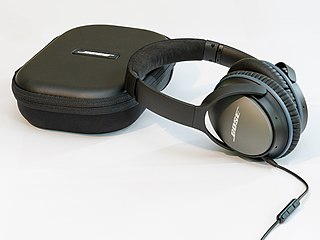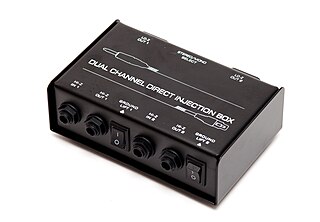This article has multiple issues. Please help improve it or discuss these issues on the talk page . (Learn how and when to remove these messages)
|
A noise-canceling microphone is a microphone that is designed to filter ambient noise.
This article has multiple issues. Please help improve it or discuss these issues on the talk page . (Learn how and when to remove these messages)
|
A noise-canceling microphone is a microphone that is designed to filter ambient noise.
The development is a special case of the differential microphone topology most commonly used to achieve directionality. All such microphones have at least two ports through which sound enters; a front port normally oriented toward the desired sound and another port that's more distant. The microphone's diaphragm is placed between the two ports; sound arriving from an ambient sound field reaches both ports more or less equally. Sound that's much closer to the front port than to the rear will make more of a pressure gradient between the front and back of the diaphragm, causing it to move more. The microphone's proximity effect is adjusted so that flat frequency response is achieved for sound sources very close to the front of the mic – typically 1 to 3 cm. Sounds arriving from other angles are subject to steep midrange and bass rolloff. Commercially and militarily useful noise-canceling microphones have been made since at least 1935 (Amelia Earhart used one on her 1935 flight from Hawaii to California [1] ) and have been made since the 1940s by Roanwell, [2] Electro-Voice [3] and others.
Another technique uses two or more microphones and active or passive circuitry to reduce the noise. The primary microphone is closer to the desired source (like a person's mouth). A second mic receives ambient noise. In a noisy environment, both microphones receive noise at a similar level, but the primary mic receives the desired sounds more strongly. Thus if one signal is subtracted from the other (in the simplest sense, by connecting the microphones out of phase) much of the noise is canceled while the desired sound is retained. Other techniques may be used as well, such as using a directional primary mic, to maximize the difference between the two signals and make the cancellation easier to do.
The internal electronic circuitry of an active noise-canceling mic attempts to subtract noise signal from the primary microphone. The circuit may employ passive or active noise canceling techniques to filter out the noise, producing an output signal that has a lower noise floor and a higher signal-to-noise ratio.
A hydrophone is a microphone designed for underwater use, for recording or listening to underwater sound. Most hydrophones contains a piezoelectric transducer that generates an electric potential when subjected to a pressure change, such as a sound wave.

A microphone, colloquially called a mic, or mike, is a transducer that converts sound into an electrical signal. Microphones are used in many applications such as telephones, hearing aids, public address systems for concert halls and public events, motion picture production, live and recorded audio engineering, sound recording, two-way radios, megaphones, and radio and television broadcasting. They are also used in computers and other electronic devices, such as mobile phones, for recording sounds, speech recognition, VoIP, and other purposes, such as ultrasonic sensors or knock sensors.

Headphones are a pair of small loudspeaker drivers worn on or around the head over a user's ears. They are electroacoustic transducers, which convert an electrical signal to a corresponding sound. Headphones let a single user listen to an audio source privately, in contrast to a loudspeaker, which emits sound into the open air for anyone nearby to hear. Headphones are also known as earphones or, colloquially, cans. Circumaural and supra-aural headphones use a band over the top of the head to hold the drivers in place. Another type, known as earbuds or earpieces, consists of individual units that plug into the user's ear canal; within that category have been developed cordless air buds using wireless technology. A third type are bone conduction headphones, which typically wrap around the back of the head and rest in front of the ear canal, leaving the ear canal open. In the context of telecommunication, a headset is a combination of a headphone and microphone.
Balanced audio is a method of interconnecting audio equipment using balanced interfaces. This type of connection is very important in sound recording and production because it allows the use of long cables while reducing susceptibility to external noise caused by electromagnetic interference. The balanced interface guarantees that induced noise appears as common-mode voltages at the receiver which can be rejected by a differential device.

Noise-cancelling headphones are headphones that suppress unwanted ambient sounds using active noise control (ANC).

Active noise control (ANC), also known as noise cancellation (NC), or active noise reduction (ANR), is a method for reducing unwanted sound by the addition of a second sound specifically designed to cancel the first. The concept was first developed in the late 1930s; later developmental work that began in the 1950s eventually resulted in commercial airline headsets with the technology becoming available in the late 1980s. The technology is also used in road vehicles, mobile telephones, earbuds, and headphones.

A DI unit is an electronic device typically used in recording studios and in sound reinforcement systems to connect a high output impedance unbalanced output signal to a low-impedance, microphone level, balanced input, usually via an XLR connector and XLR cable. DIs are frequently used to connect an electric guitar or electric bass to a mixing console's microphone input jack. The DI performs level matching, balancing, and either active buffering or passive impedance matching/impedance bridging. DI units are typically metal boxes with input and output jacks and, for more expensive units, “ground lift” and attenuator switches.

A telephone call or telephone conversation, also known as a phone call or voice call, is a connection over a telephone network between the called party and the calling party. Telephone calls started in the late 19th century. As technology has improved, a majority of telephone calls are made over a cellular network through mobile phones or over the internet with Voice over IP. Telephone calls are typically used for real-time conversation between two or more parties, especially when the parties cannot meet in person.

A hearing aid is a device designed to improve hearing by making sound audible to a person with hearing loss. Hearing aids are classified as medical devices in most countries, and regulated by the respective regulations. Small audio amplifiers such as personal sound amplification products (PSAPs) or other plain sound reinforcing systems cannot be sold as "hearing aids".

A sound reinforcement system is the combination of microphones, signal processors, amplifiers, and loudspeakers in enclosures all controlled by a mixing console that makes live or pre-recorded sounds louder and may also distribute those sounds to a larger or more distant audience. In many situations, a sound reinforcement system is also used to enhance or alter the sound of the sources on the stage, typically by using electronic effects, such as reverb, as opposed to simply amplifying the sources unaltered.

Beamforming or spatial filtering is a signal processing technique used in sensor arrays for directional signal transmission or reception. This is achieved by combining elements in an antenna array in such a way that signals at particular angles experience constructive interference while others experience destructive interference. Beamforming can be used at both the transmitting and receiving ends in order to achieve spatial selectivity. The improvement compared with omnidirectional reception/transmission is known as the directivity of the array.

Field recording is the production of audio recordings outside recording studios, and the term applies to recordings of both natural and human-produced sounds. It can also include the recording of electromagnetic fields or vibrations using different microphones like a passive magnetic antenna for electromagnetic recordings or contact microphones, or underwater field recordings made with hydrophones to capture the sounds and/or movements of whales, or other sealife. These recordings are often regarded as being very useful for sound designers and foley artists.

There are a number of well-developed microphone techniques used for recording musical, film, or voice sources or picking up sounds as part of sound reinforcement systems. The choice of technique depends on a number of factors, including:

In-ear monitors, or simply IEMs or in-ears, are devices used by musicians, audio engineers and audiophiles to listen to music or to hear a personal mix of vocals and stage instrumentation for live performance or recording studio mixing. They are also used by television presenters to receive vocal instructions, information and breaking news announcements from a producer that only the presenter hears. They are often custom-fitted to an individual's ears to provide comfort and a high level of noise reduction from ambient surroundings. Their origins as a tool in live music performance can be traced back to the mid-1980s.

The proximity effect in audio is an increase in bass or low frequency response when a sound source is close to a directional or cardioid microphone. Proximity effect is a change in the frequency response of a directional pattern microphone that results in an emphasis on lower frequencies. It is caused by the use of ports to create directional polar pickup patterns, so omni-directional microphones do not exhibit the effect

A headset is a combination of headphone and microphone. Headsets connect over a telephone or to a computer, allowing the user to speak and listen while keeping both hands free. They are commonly used in customer service and technical support centers, where employees can converse with customers while typing information into a computer. They are also common among computer gamers and let them talk with each other and hear others while using their keyboards and mice to play the game.
Echo suppression and echo cancellation are methods used in telephony to improve voice quality by preventing echo from being created or removing it after it is already present. In addition to improving subjective audio quality, echo suppression increases the capacity achieved through silence suppression by preventing echo from traveling across a telecommunications network. Echo suppressors were developed in the 1950s in response to the first use of satellites for telecommunications.
Adaptive noise cancelling is a signal processing technique that is highly effective in suppressing additive interference or noise corrupting a received target signal at the main or primary sensor in certain common situations where the interference is known and is accessible but unavoidable and where the target signal and the interference are unrelated, that is, uncorrelated. Examples of such situations include:

The Sennheiser MD 421 is a German cardioid dynamic microphone, widely used for speech in broadcasting and for music in live concerts and the recording studio. Introduced in 1960, the internal large-diaphragm transducer element of the MD 421 is still produced unchanged by Sennheiser. The MD 421 is considered a classic, an industry standard. More than 500,000 units have been sold.